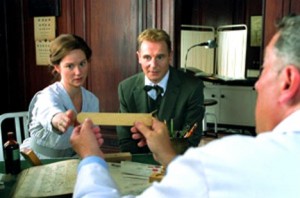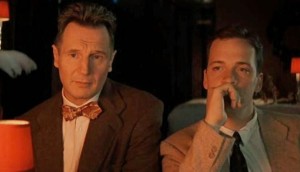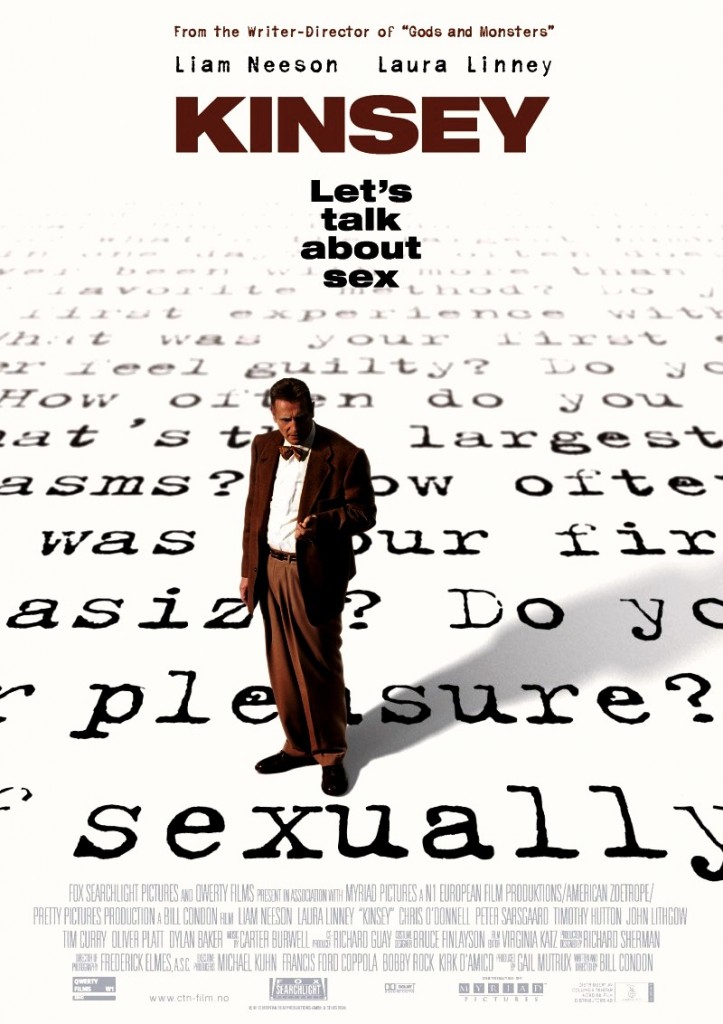
“The gap between what we assume people do sexually and what they actually do, is enormous.” – Alfred C. Kinsey
Enlightening for our new generation to understand how our elders were brought up on the issues of sex. Kinsey (2004) is a tremendous film that not only considers sex in the 20th century but considers, and brilliantly recognizes, our changes of value systems in the generation gap as well. This is a mature and adult film that discusses sex freely, and alas, demonstrates sexual behavior freely. Graphic without being too in-your-face.
Although there is never a direct comparison in the film, Kinsey shares something in common with Playboy publisher Hugh Hefner: he grew up in a repressed home where displays of affection such as hugging were disapproved. It makes sense that men like these became preoccupied with sex in their profession, as it stemmed out of a desire to compensate for the lack of affection that they experienced as young boys.
Liam Neeson stars as Kinsey, who plays him as a credibly uptight repressive turned renegade against the outdated “morals” of America. He appears as a fastidiously dressed intellectual who projected the very image of strait-laced with his bow-ties and meticulously neat suits. His background? Kinsey was browbeaten by his puritanical father (John Lithgow) at a young age to be neat, upstanding, and chaste to God.
 Remaining a virgin well into his adult age, Kinsey started his career as an Indiana university professor and researcher of gall wasps, an insect that he knew more about than women. Attractive student Clara McMillen (Laura Linney, who received the film’s one Oscar nomination for best supporting actress) is the first to break his rigid exterior. They have a brief and awkward courtship before they get married. The wedding night is a disaster. They visit a professional doctor in order to get information on how to resolve their bedroom problem.
Remaining a virgin well into his adult age, Kinsey started his career as an Indiana university professor and researcher of gall wasps, an insect that he knew more about than women. Attractive student Clara McMillen (Laura Linney, who received the film’s one Oscar nomination for best supporting actress) is the first to break his rigid exterior. They have a brief and awkward courtship before they get married. The wedding night is a disaster. They visit a professional doctor in order to get information on how to resolve their bedroom problem.
Following successful consummation, sex becomes an obsession at home and work. Kinsey is eager to share his bedroom knowledge with anyone that will listen. Kinsey appoints himself as a campus advisor to young married couples whom are confused and uneasy about sexual practices. When he receives a research grant, he goes to work collecting data on men’s and women’s sexual activities in the same skillful method that he collected data on gall wasps. The results of his search are unpredictable, enlightening, beguiling.
Kinsey teaches a sex course that is unlike anything that is being taught anywhere else in the country. The rest of the country is learning that abstinence is the best sexual practice, and that sex brings disease – our forefathers were being taught fear. Masturbation was evil. Oral sex was evil. Pre-marital sex was evil. Anything but the missionary position was evil.
People would still practice the “forbidden,” but they were taught to feel shame about it. Kinsey took away some of that guilt when he shared research with the world of what Americans practiced in the bedrooms. He also created a barometer that revealed what was truly normal. There was controversy, even notoriety. But America might still be living in a Victorian age if it weren’t for him.
Directed and written by Bill Condon (“Gods and Monsters”), the film continues to dramatize the transformative period when people began to talk openly about sex (Kinsey’s research assistants are guileless in conversations about sex to a fault). “Sexual Behavior in the Human Male” became the highly regarded statistical manual released in 1948, while the female volume came out in 1953. The  findings, of course, ignited an uproar. Such as the statistic that half of married women had had premarital sex and that 37% of American men had had at least one homosexual encounter. Kinsey’s most angry opponents were the ones that declared the survey as morally absent and irresponsible. So yes, the film openly deals with issues of homosexuality, bisexuality, marital infidelity, masturbation and oral copulation – nothing goes unmentioned.
findings, of course, ignited an uproar. Such as the statistic that half of married women had had premarital sex and that 37% of American men had had at least one homosexual encounter. Kinsey’s most angry opponents were the ones that declared the survey as morally absent and irresponsible. So yes, the film openly deals with issues of homosexuality, bisexuality, marital infidelity, masturbation and oral copulation – nothing goes unmentioned.
People were still shy when this film came out in 2004, leaving it barely attended. I can imagine the general audience fear: Those topics are embarrassing! What the film does, if given the chance, is approach such taboos tastefully and with reserve for intelligent contemplation. The film doesn’t ridicule anybody except sex criminals.
 Kinsey experiments with homosexuality with fellow researcher Clyde Martin, played by Peter Sarsgaard. But it was his wife Clara who taught him the necessity of restrictions, boundaries and loyalty. The film ends wistfully, though a little more epilogue impact could have immortalized the film more potently. Co-stars include Oliver Platt as the Indiana University President, Timothy Hutton and Chris O’Donnell as research recorders, Tim Curry as an uptight academic, Dylan Baker as a chief at the Rockefeller Foundation, and William Sadler as a gloating sex deviant.
Kinsey experiments with homosexuality with fellow researcher Clyde Martin, played by Peter Sarsgaard. But it was his wife Clara who taught him the necessity of restrictions, boundaries and loyalty. The film ends wistfully, though a little more epilogue impact could have immortalized the film more potently. Co-stars include Oliver Platt as the Indiana University President, Timothy Hutton and Chris O’Donnell as research recorders, Tim Curry as an uptight academic, Dylan Baker as a chief at the Rockefeller Foundation, and William Sadler as a gloating sex deviant.
118 Minutes. Rated R.
HISTORICAL DRAMA / FOOD FOR THOUGHT / SPRING AWAKENING
Film Cousins: “Gods and Monsters” (1998); “The Century of the Self” (2002, Great Britain); “A Dangerous Method” (2011); “Hysteria” (2012).





